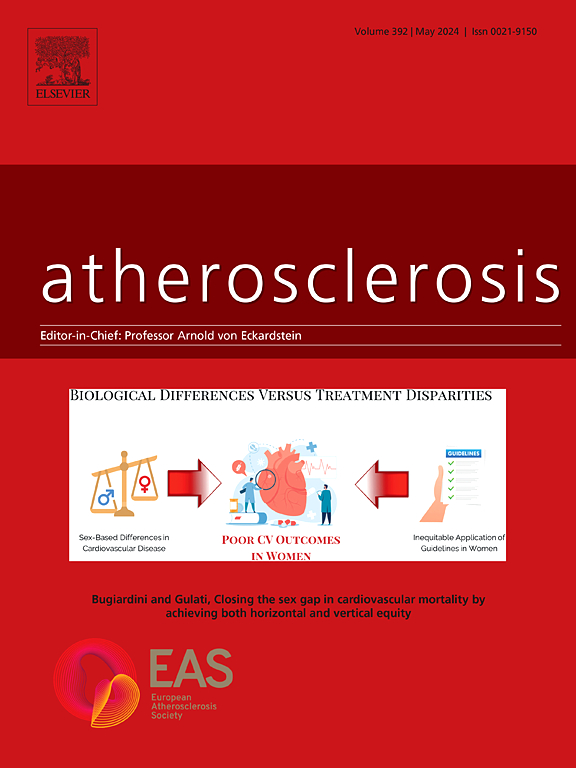Evinacumab and reduced lipoprotein apheresis in pediatric homozygous familial hypercholesterolemia: a retrospective study on LDL-C
IF 4.9
2区 医学
Q1 CARDIAC & CARDIOVASCULAR SYSTEMS
引用次数: 0
Abstract
Background and aims
Homozygous familial hypercholesterolemia (HoFH) is a rare genetic disorder characterized by severely elevated low-density lipoprotein cholesterol (LDL-C) from birth, leading to accelerated atherosclerotic cardiovascular disease and premature death if untreated. Evinacumab, a monoclonal antibody targeting angiopoietin-like 3 (ANGPTL3), offers an LDL receptor-independent pathway to lower LDL-C. This study aimed to evaluate the effect of evinacumab on lipid levels and its potential to reduce lipoprotein apheresis (LA) frequency in children and adolescents with HoFH.
Methods
This was a single-center, retrospective, observational study of six patients aged 10–19 years who had genetically confirmed HoFH and were treated with stable doses of lipid-lowering therapy (LLT) and evinacumab with or without LA at the Medical University of Vienna. Demographic characteristics, lipid levels, and treatment details were collected.
Results
At the first visit, LDL-C levels ranged from 521 to 870 mg/dL (13.5–22.5 mmol/L). With stable LLT plus LA, pre-LA LDL-C levels were reduced to 212–352 mg/dL (5.5–9.1 mmol/L) and, after evinacumab was added, further reductions to 90–201 mg/dL (2.3–5.2 mmol/L) were observed. However, during periods of reduced LA frequency, pre-LA LDL-C levels increased to 105–216 mg/dL (2.7–5.6 mmol/L), exceeding the target of 115 mg/dL (3.0 mmol/L) in three out of four patients. LA frequency reduction from weekly to three times per month was only possible in one patient, but no patients had termination of LA.
Conclusions
Evinacumab effectively lowers LDL-C in children and adolescents with HoFH. However, its ability to facilitate long-term reduction in LA frequency was not shown and remains unclear.

Evinacumab和降低脂蛋白分离治疗儿童纯合子家族性高胆固醇血症:一项关于LDL-C的回顾性研究
背景和目的:杂合性家族性高胆固醇血症(HoFH)是一种罕见的遗传性疾病,其特征是低密度脂蛋白胆固醇(LDL-C)从出生起就严重升高,如果不治疗,可导致动脉粥样硬化性心血管疾病加速和过早死亡。Evinacumab是一种靶向血管生成素样3 (ANGPTL3)的单克隆抗体,提供了一种不依赖LDL受体的途径来降低LDL- c。本研究旨在评估evinacumab对儿童和青少年HoFH患者血脂水平的影响及其降低脂蛋白分离(LA)频率的潜力。方法:这是一项单中心、回顾性、观察性研究,在维也纳医科大学接受了6例年龄在10-19岁的遗传证实的HoFH患者,他们接受了稳定剂量的降脂治疗(LLT)和evinacumab治疗,有或没有LA。收集了人口统计学特征、血脂水平和治疗细节。结果首次访视时,患者LDL-C水平为521 ~ 870 mg/dL (13.5 ~ 22.5 mmol/L)。使用稳定的LLT + LA, LA前LDL-C水平降至212-352 mg/dL (5.5-9.1 mmol/L),添加evinacumab后,进一步降至90-201 mg/dL (2.3-5.2 mmol/L)。然而,在LA频率降低期间,LA前LDL-C水平升高至105-216 mg/dL (2.7-5.6 mmol/L),超过了4例患者中的3例115 mg/dL (3.0 mmol/L)的目标。LA频率从每周一次减少到每月三次仅在一名患者中可行,但没有患者终止LA。结论sevinacumab可有效降低儿童和青少年HoFH患者的LDL-C。然而,其促进长期减少LA频率的能力尚未显示,目前仍不清楚。
本文章由计算机程序翻译,如有差异,请以英文原文为准。
求助全文
约1分钟内获得全文
求助全文
来源期刊

Atherosclerosis
医学-外周血管病
CiteScore
9.80
自引率
3.80%
发文量
1269
审稿时长
36 days
期刊介绍:
Atherosclerosis has an open access mirror journal Atherosclerosis: X, sharing the same aims and scope, editorial team, submission system and rigorous peer review.
Atherosclerosis brings together, from all sources, papers concerned with investigation on atherosclerosis, its risk factors and clinical manifestations. Atherosclerosis covers basic and translational, clinical and population research approaches to arterial and vascular biology and disease, as well as their risk factors including: disturbances of lipid and lipoprotein metabolism, diabetes and hypertension, thrombosis, and inflammation. The Editors are interested in original or review papers dealing with the pathogenesis, environmental, genetic and epigenetic basis, diagnosis or treatment of atherosclerosis and related diseases as well as their risk factors.
 求助内容:
求助内容: 应助结果提醒方式:
应助结果提醒方式:


